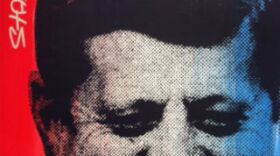Throughout November, KERA will mark the 50th anniversary of the John F. Kennedy assassination by taking a closer look at that fateful day, what it meant to the country, how it changed Dallas, and more.
Today, we take a look at Dr. Red Duke, who worked to save the life of John Connally, the Texas governor who was wounded after bullets struck Kennedy's motorcade. Connally sat in front of Kennedy. KERA's BJ Austin has the story:
Earlier this year, a doctor at Parkland Hospital in 1963 spoke publicly for the first time about his role after bullets struck Kennedy's motorcade in downtown Dallas.
Dr. Red Duke, a renowned trauma surgeon from Houston, was on the thoracic surgery team at Parkland Hospital in 1963. His job that day was to help save the life of wounded Texas Governor John Connally, also shot as he rode in the motorcade. After 50 years, he told his story for the first time to hundreds of emergency medicine doctors and technicians gathered at the Dallas Sheraton hotel for an annual conference.
“We didn’t talk much about it," Duke told his audience. "Well, I never have. This is the first time I’ve ever said anything about it.”
Dr. Duke recalled going downstairs to the Emergency Room, seeing crowds of people, as well as Jacqueline Kennedy, sitting on a chair outside Trauma Room 1 – her pink suit stained with blood. He entered, saw the president’s devastating head wound, and was quickly shifted to Trauma Room 2 to take care of the governor.
“He had this big chest wound. His lung was flopping in and out," Duke recalled. "So I stopped it up and put a chest tube in him – just like you do any other gunshot wound.”
But it was the governor of Texas, and it was a day like no other. Dr. Duke says after he stabilized Connally, the governor was rushed into surgery. And, for the first time ever, they had a radio in the operating room.
“We heard all the things. The president’s been pronounced dead. And all the other events that followed. We heard about the officer being shot over in Oak Cliff,” Duke said.
After chest surgery, more doctors arrived to repair bullet damage to Connally’s right wrist and retrieve a fragment of bullet lodged in his thigh, near the femoral artery.
Two days later, Dr. Duke was back in a trauma room working to save the life of accused assassin Lee Harvey Oswald, who was shot by Jack Ruby.
Dr. Duke says after the events of that November, he got out of town. He went deer hunting in Pampa, Texas – a nice place to hide, he said. He says he worked that day using his training and instinct, trying to save his patient.
Any thoughts of a place in history had to wait.
[Update, August 2015: Duke died in Houston. He was 86. Learn more about Duke and watch his TV medical reports through the years.]
KERA wants to hear your JFK stories and memories. Email us at jfk@kera.org. We may contact you or use your memory in an upcoming story.








